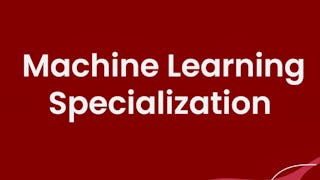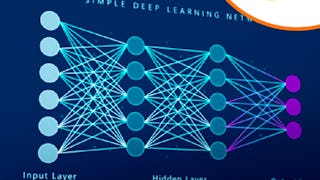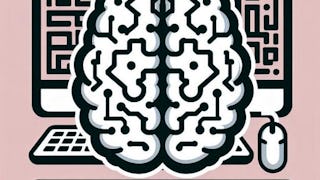This Course Machine Learning offers a comprehensive, hands-on introduction to building and deploying machine learning models using Python. It is designed for learners with a foundational understanding of Python programming and familiarity with basic data analysis concepts. The course begins with a quick review of essential Python libraries such as NumPy, pandas, and Matplotlib, which form the foundation for data manipulation and visualization in data science.



Recommended experience
What you'll learn
Learn to frame real-world challenges as machine learning problems. Gain hands-on experience using Python to build and evaluate models.
Skills you'll gain
- Regression Analysis
- Pandas (Python Package)
- Machine Learning
- Supervised Learning
- Data Analysis
- Applied Machine Learning
- Tensorflow
- Artificial Neural Networks
- Python Programming
- Data Science
- Computer Vision
- Image Analysis
- Machine Learning Algorithms
- Matplotlib
- Scikit Learn (Machine Learning Library)
- Deep Learning
- Natural Language Processing
- Predictive Modeling
- NumPy
Details to know

Add to your LinkedIn profile
June 2025
16 assignments
See how employees at top companies are mastering in-demand skills

There are 12 modules in this course
Welcome to the Machine Learning course! In this course, you will gain an in-depth introduction to building machine-learning models using Python. In this course, you will initially recapitulate the key Python libraries which are useful for Data Science applications. This includes coverage of Python libraries like Matplotlib, NumPy, and pandas. Next, you are introduced to the basics of machine learning, and the various classification and regression techniques are discussed. Also, the implementation of these techniques using the popular scikit-learn package is covered in detail. Artificial neural networks and the concept of deep learning is next explored with hands-on implementation of regression and classification algorithms using TensorFlow. As businesses increasingly draw insights from unstructured data (text, images, etc.), you would also get insights into neural networks-based deep learning models for the analysis of text and images. This is an advanced-level course, intended for learners with a background using predictive tools and techniques, and a basic understanding of Python programming concepts. The knowledge you gain from this course will help your career as a business analyst or a data engineer and even work toward becoming a data scientist. You will gain skills to apply machine learning algorithms to structured and unstructured data to draw management insights.
What's included
1 video
Data science is an exciting new field used by various organizations to perform data-driven decisions. It is a combination of technical knowledge, mathematics, and business. In this module, we will use Python, one of the most popular languages among all the languages used by data scientists. We will also understand various topics of data science and how to apply them in a real-world scenario.
What's included
8 videos5 readings2 assignments1 discussion prompt
This assessment is a graded quiz based on the modules covered this week.
What's included
1 assignment
In this module, you will learn about the origin and evolution of machine learning. You will also learn the different ways a machine can learn, and the essential components needed to develop a machine-learning model. You will get an overview of different types of algorithms that you can use to train machine-learning models for specific business problems. The nature and type of data needed to train these algorithms will also be discussed. The module also discusses the different real-world and business best practices and challenges one will have to be sensitive to while deploying machine learning to support business operations.
What's included
9 videos2 readings2 assignments
In this module, you will re-examine several machine learning models. We will discuss hands-on tasks that machine learning is commonly applied to, and you will learn to measure the performance of machine learning systems. We will work with a popular library for the Python programming language called scikit-learn, which has assembled state-of-the-art implementations of many machine learning algorithms.
What's included
9 videos4 readings2 assignments1 discussion prompt
This assessment is a graded quiz based on the modules covered this week.
What's included
1 assignment
In this module, you will learn about artificial neural networks (ANNs) and their role in machine learning. You will also learn about the perceptron, the first real-world application based on neural networks. The concepts of weights, biases, and activation functions along with their role in analyzing data and training of ANNs will be discussed. We will also discuss how concepts like backpropagation and gradient descent affect the process of learning with ANNs.
What's included
6 videos2 readings2 assignments
In this module, you will learn about using neural network technique for predictive tasks. You will also learn how to use the Python open source TensorFlow machine learning library for implementing regression and classification models to draw insights from structured and unstructured text data. The module also discusses methods for hyperparameter tuning for performance improvement. Lastly, this module will help you to define deep learning models and look at the problem of overfitting and look at ways to identify and overcome it.
What's included
11 videos4 readings2 assignments1 discussion prompt
This assessment is a graded quiz based on the module covered this week.
What's included
1 assignment
In this module, you will be introduced to the concept of word and image embeddings which are transforming natural language and image processing applications. You will learn how to generate word embeddings using a corpus of text and also use pre trained word embeddings like Glove and Fasttext. This module will also discuss convolution neural networks and image vector-based models for image classification tasks.
What's included
11 videos4 readings2 assignments1 discussion prompt
This assessment is a graded quiz based on the modules covered this week.
What's included
1 assignment
This module describes the learning objectives, and submission instructions for the End-term Assignment for the course.
What's included
1 video
Earn a career certificate
Add this credential to your LinkedIn profile, resume, or CV. Share it on social media and in your performance review.
Build toward a degree
This course is part of the following degree program(s) offered by O.P. Jindal Global University. If you are admitted and enroll, your completed coursework may count toward your degree learning and your progress can transfer with you.¹
Instructor

Offered by
Explore more from Machine Learning
 Status: Free Trial
Status: Free TrialUniversity of Washington
 Status: Free Trial
Status: Free TrialDeepLearning.AI
 Status: Free Trial
Status: Free Trial Status: Free Trial
Status: Free TrialJohns Hopkins University
Why people choose Coursera for their career





Open new doors with Coursera Plus
Unlimited access to 10,000+ world-class courses, hands-on projects, and job-ready certificate programs - all included in your subscription
Advance your career with an online degree
Earn a degree from world-class universities - 100% online
Join over 3,400 global companies that choose Coursera for Business
Upskill your employees to excel in the digital economy
Frequently asked questions
To access the course materials, assignments and to earn a Certificate, you will need to purchase the Certificate experience when you enroll in a course. You can try a Free Trial instead, or apply for Financial Aid. The course may offer 'Full Course, No Certificate' instead. This option lets you see all course materials, submit required assessments, and get a final grade. This also means that you will not be able to purchase a Certificate experience.
When you purchase a Certificate you get access to all course materials, including graded assignments. Upon completing the course, your electronic Certificate will be added to your Accomplishments page - from there, you can print your Certificate or add it to your LinkedIn profile.
You will be eligible for a full refund until two weeks after your payment date, or (for courses that have just launched) until two weeks after the first session of the course begins, whichever is later. You cannot receive a refund once you’ve earned a Course Certificate, even if you complete the course within the two-week refund period. See our full refund policy.
More questions
Financial aid available,


